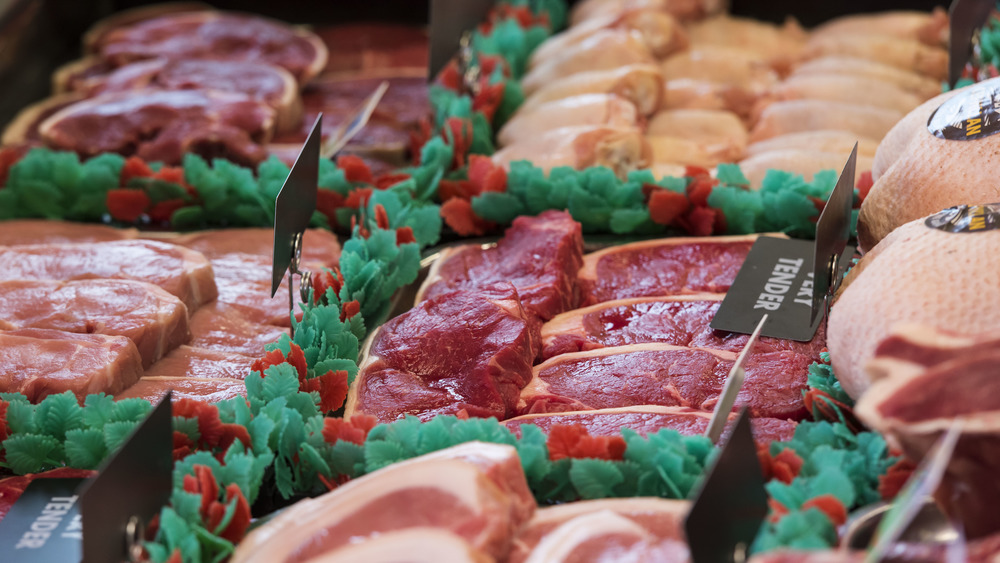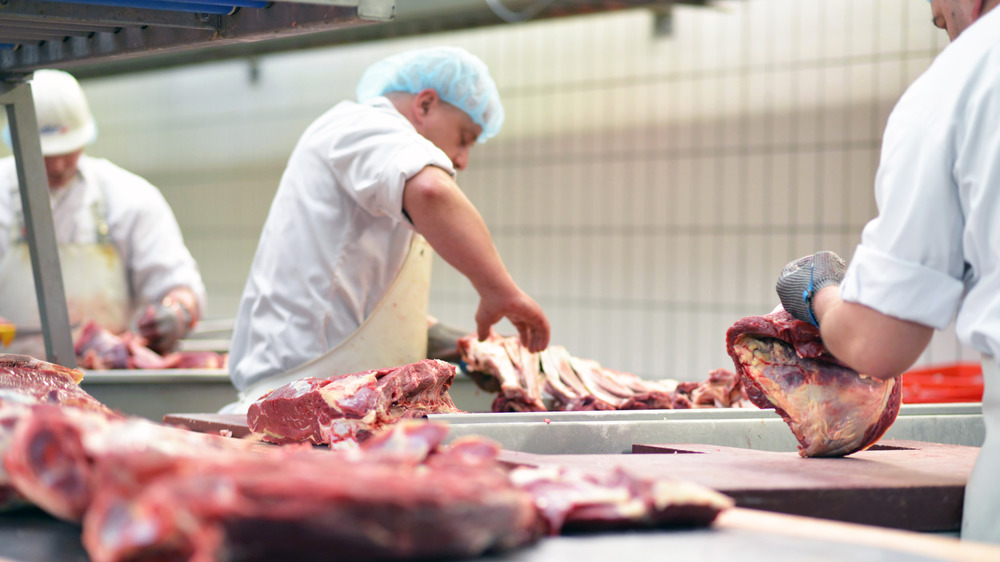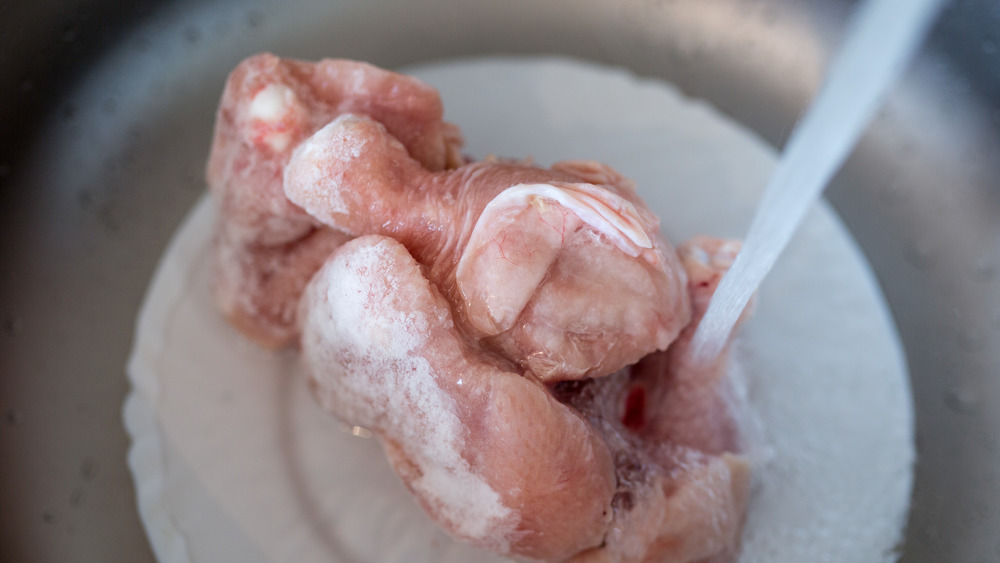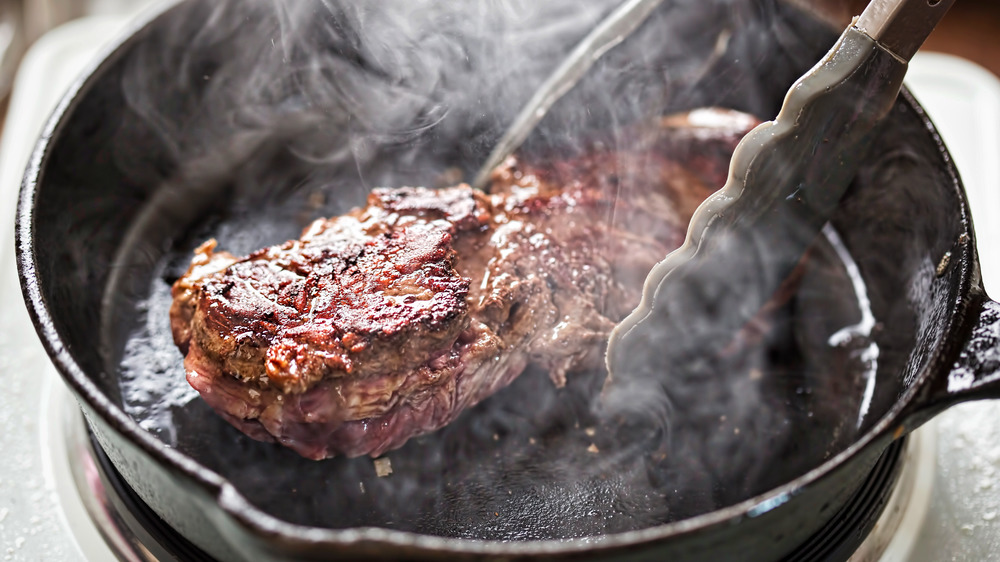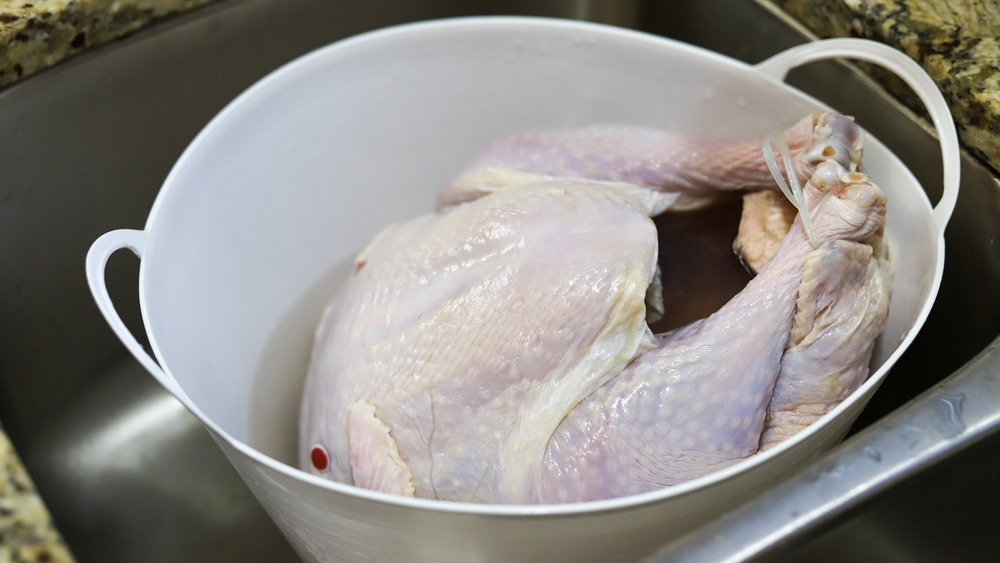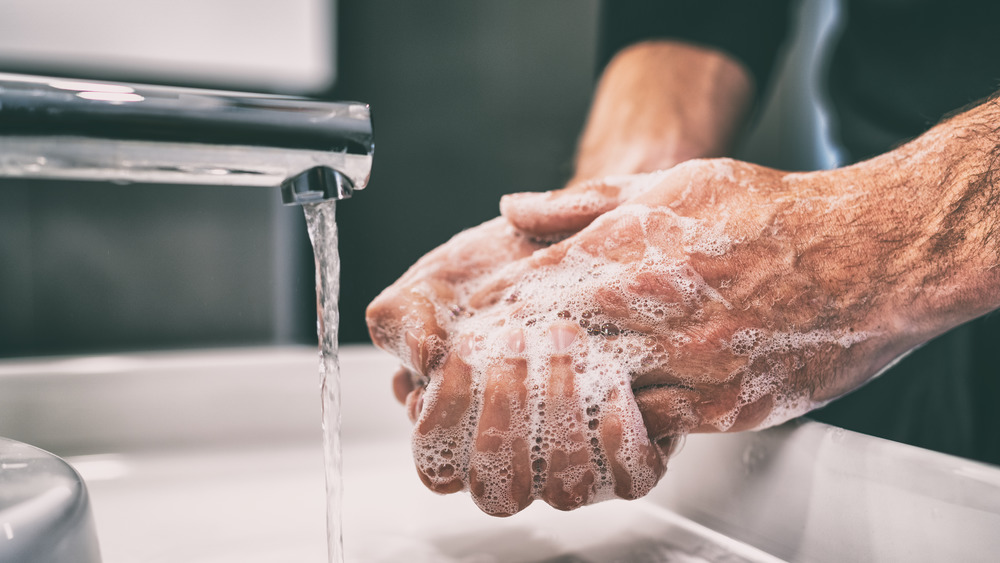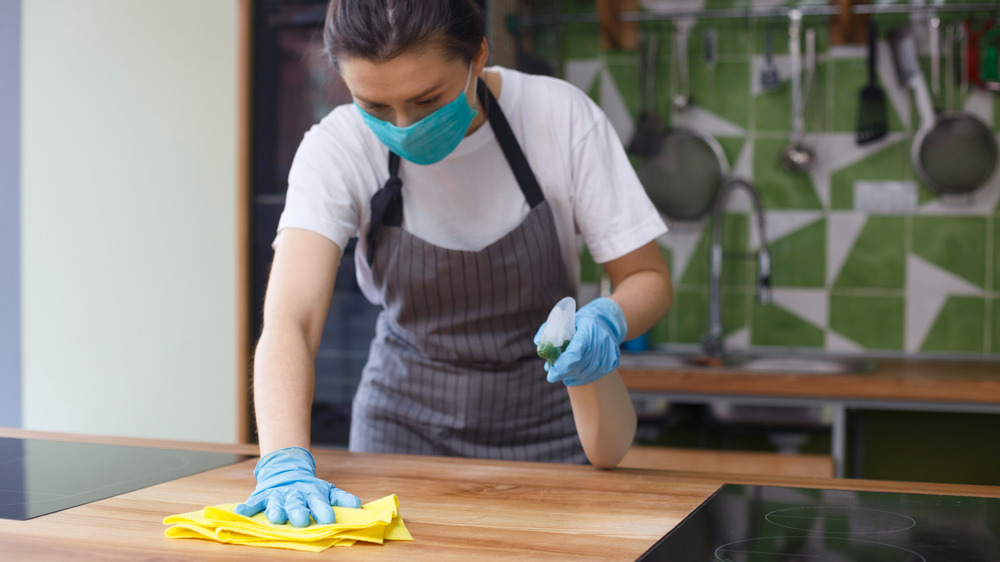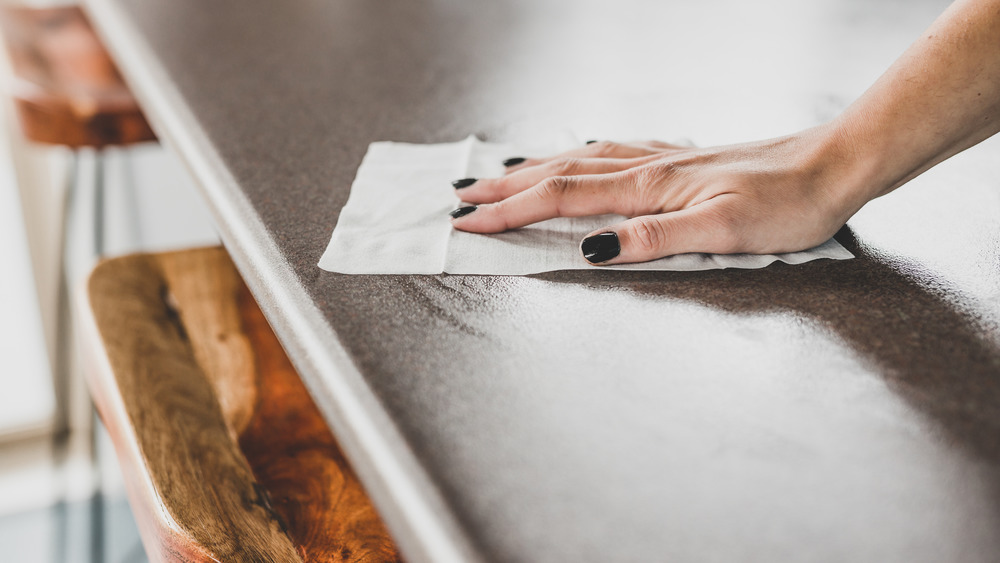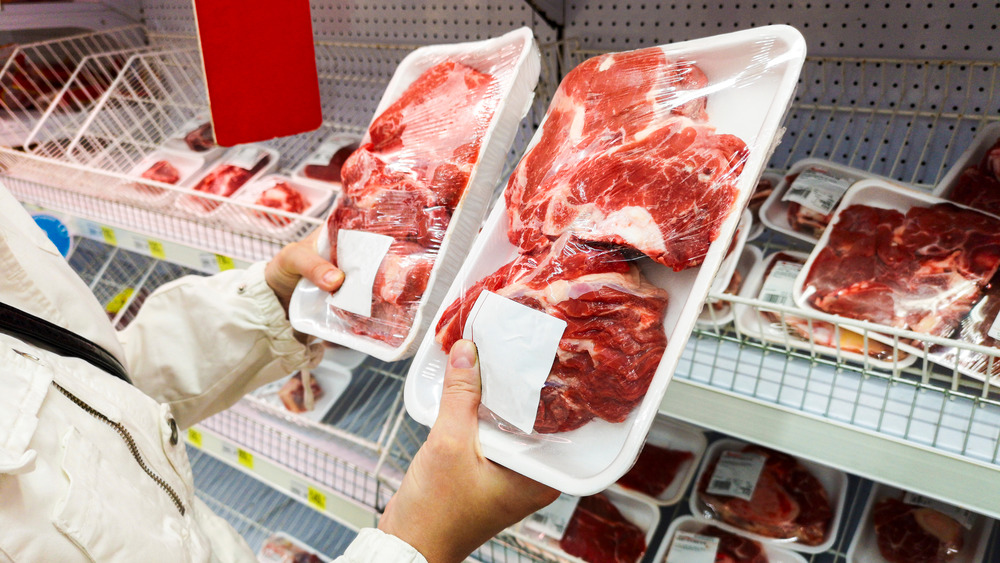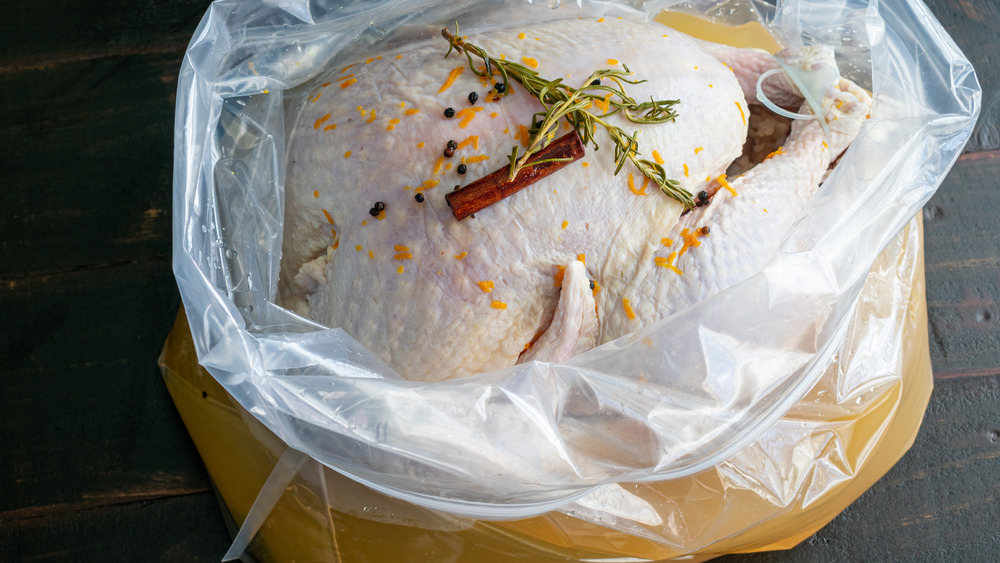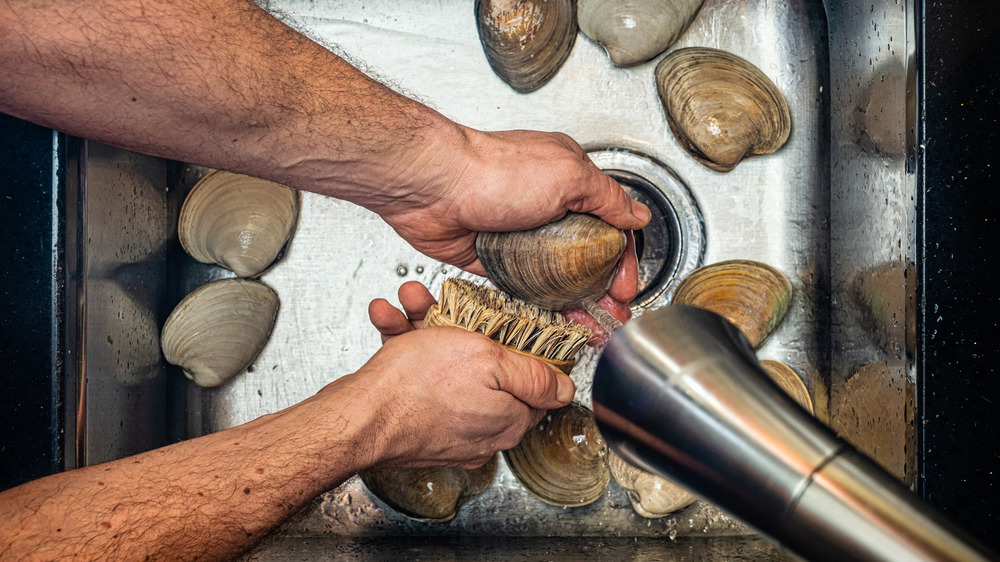Mistakes Everyone Makes When Washing Raw Meat
Imagine it. You're ready to cook up a nice, juicy steak, some chicken thighs, or maybe a pork loin. Whether it's fresh or once frozen and now thawed, you have a ready-to-cook cut of raw meat, and you're starting your food prep. Once you take that cut of meat out of its packaging, what's your first step? If you answered with something along the lines of "wash the meat" or "rinse the meat off in the sink," then you may be making some serious mistakes — mistakes that could cause you and your entire household to fall seriously ill (and maybe even die).
Still, it's something that many people do without thinking about the potential consequences, much like eating raw cookie dough or thawing your frozen foods out on the counter over the course of an entire day. Maybe it's something your parents or grandparents did without a thought, so you assume it must be safe, or even in the case of rinsing meat off before cooking, the right and best thing to do.
However, if you want to ensure you're keeping your kitchen (and the food that comes out of it) as safe as possible, you'll want to avoid some certain mistakes.
Believing the lie that unwashed raw meat is unsafe meat
For many consumers, washing raw meat is a necessary step to ensure food safety (when, in fact, it's the absolute opposite). According to one Redditor, "Wouldn't you want to wash away the blood/grime prior to cooking? Haven't you seen butchers? They are not (usually) the cleanest place around. The argument is from a hygiene perspective and not a taste point of view."
Another Redditor agreed, saying, "I always wash my meat. God knows how clean the meat plant was, who packed this meat, how many hands or feces touched it, if it fell on the floor, etc."
But as many fellow commenters pointed out, most of the mess and uncleanliness you might spot in a local butcher's shop is usually tied to recent work, not necessarily an overarching disregard for proper food handling. And in many cases, a butcher's shop will be more sanitary than the average home kitchen. Likewise, others noted that even if there was something unsightly living on your raw meat once you get it home, it shouldn't survive the cooking method if you cook your food until completely done.
Taking this raw meat-washing myth to heart
The myth, refuted or not, that unwashed meat is unclean — and therefore unsafe — leads to one of the biggest cooking mistakes of all, at least when it comes to handling raw meat: washing your raw meat in the first place. Rather than simply rinsing off all of that food-borne illness-causing bacteria and sending it down the drain like you might assume you're doing, washing your raw meat actually doesn't really get rid of the bacteria at all, according to a report from Michigan State University, and, instead, spreads it around further, meaning those who wash raw meat are at a higher risk for food poisoning.
Think you can wash your raw meat then sanitize or bleach your sink and then you'll be good to go? Think again. The same report notes that, when you wash raw meat, the bacteria can actually spread up to three feet from where the raw meat was washed, meaning a lot of the surfaces in your kitchen are compromised. You don't even get clean, bacteria-free raw meat for your trouble, either, as the residual bacteria on the meat will just follow it to your cookware (though, no worries, the bacteria is killed during the cooking process).
Reducing the overall quality of your raw meat
But beyond all of the health risks that come with washing your raw meat ahead of cooking it, you're also potentially reducing the overall quality of your finished dish, meaning all that cash you dropped on a fancy steak or prime cut of organic, grass-fed, locally-raised chicken is going right down the drain along with all of those supposed, rinsed-off germs. How so?
Well, firstly, think about the tastiest cut of meat you've ever enjoyed. What color was it? Likely, if it was any cut of chicken, it wasn't a pale, white piece of meat on your plate, or if it was a steak, it wasn't a boring beige. There were char marks, cooked fat, crispy and brown skin — all of the things that indicate a cut of meat is finished and full of flavor. All of those colors and flavors are caused by chemical reactions, and when you rinse off your raw meat before cooking it, you prolong the amount of time it takes for those chemical reactions to occur. All the science talk aside, it basically means your steak (or chicken or pork) will cook far faster on the inside than it browns on the outside, resulting in a lackluster finished product that's probably dry and not as tasty as you'd prefer.
Giving your food a raw meat bath
Some consumers go beyond simply giving their raw meat a brief shower and opt for an entire, hours-long bath, which they say not only impacts the cleanliness of the meat but also the taste. As one of the Redditors who responded to the thread mentioned above said, "I was brought up to always clean chicken and, I dunno [sic] if it's psychological, but I can taste a difference if I don't clean it now. I don't just rinse it though. I soak [it] in water plus salt plus vinegar for a little bit and then rinse and dry."
This type of soak is different from a brine, which the USDA clarifies does not include any rinsing or washing and always takes place in the fridge, in a covered and sealed container, in order to keep the meat at a safe temperature.
Simply soaking the meat in your sink, for the intentions of washing bacteria or any other undesirable substances off your raw meat (for example, some may decide to soak saltier cuts of pork in an attempt to remove some of the salt), is useless, the USDA notes. If you, for some reason, do decide to soak your meat, the department recommends following a method similar to brining, using only a sanitized and sealed container in the refrigerator, rather than your sink.
Not washing the most important thing when cooking raw meat
Instead of washing off your raw meat before cooking, one of the best things you can do when working with raw meat in the kitchen is to simply make sure your hands are always clean in order to prevent cross contamination. The University of Michigan recommends washing your hands for at least 20 seconds with warm water and plenty of soap, with at least 15 seconds of scrubbing before another warm water rinse. Then, skip drying your hands on your jeans and opt for a clean hand towel.
But preventing cross contamination and, as a result, food-borne illnesses, in the kitchen means a lot more than just washing your hands after handling raw meat. It's recommended that you also follow good hand-washing habits in general, being sure to wash after using the restroom, touching any pets, or changing diapers, as you never know when you'll carry harmful germs or bacteria from one of these activities with you over into your kitchen.
Not cleaning up your kitchen after cooking (or washing) raw meat
Whether or not you wash or soak your raw meat, if raw meat is in your kitchen at all, you need to properly clean all of the surfaces in your kitchen, including countertops, your sink, and any used cutting boards or utensils. However, there's a difference between sanitizing and disinfecting these surfaces, and it's important to know the difference so that you can properly clean your kitchen.
According to the USDA, sanitizing products are often safe to use on items that touch your food, such as utensils or cutting boards. You can buy kitchen-safe sanitizers or make your own with a bit of water and bleach. Likewise, your dishwasher can sanitize many of the items in your kitchen that you might often use when cooking raw meat. Disinfectants, on the other hand, usually include products that are not safe for use on items that touch your food. Instead, disinfectants are best for areas like countertops or sinks.
After sanitizing and disinfecting, make sure to wash your hands, too, and don't forget to throw any cleaning cloths or towels you might've used into the wash on a high heat setting.
Only sanitizing or disinfecting after preparing raw meat
If you think that if you sanitize and disinfect your kitchen countertops and any utensils you may have used in preparing your raw meat that you're free and clear from any potential food-borne illnesses, you may want to think again. Sanitizing and disinfecting alone aren't always enough, according to the USDA. In fact, there are multiple steps to properly cleaning your kitchen following handling, soaking, or washing raw meat, and the first step isn't sanitizing or disinfecting — it's cleaning everything with good, old fashioned warm water and soap.
The USDA says that cleaning your kitchen with warm and soapy water before you move on to either sanitizing or disinfecting will remove any extra debris or particles as well as some bacteria. While it's not good enough on its own, it does make the sanitizing and/or disinfecting more effective.
So, however you handle raw meat in your kitchen, remember to clean all your surfaces and utensils with warm, soapy water, allow everything to air dry or use disposable towels, move on to sanitizing or disinfecting, and finally, wash your hands before going on with your day.
Not throwing away this one thing immediately after preparing raw meat
You're getting a meal ready, you're moving between different dishes and prep areas in your kitchen, and you're juggling multiple tasks at once (not to mention any outside distractions, from other family members to incoming texts) — it can be all too easy to simply toss some of your foods' packaging materials to one side and say you'll clean up later. However, this is one mistake you won't want to make when handling raw meats, regardless of whether or not you wash your raw meat.
The USDA says that plastic wrap, foam trays, and other meat packaging can harbor bacteria from whatever they contained far after their original use, meaning they could contaminate other foods, your hands, and even your kitchen counters. Your best bet is to throw any raw meat packaging away immediately. And definitely do not, under any circumstances, reuse the packaging for something else (even egg cartons, which are sometimes used in children's crafts, are considered a cross-contamination threat and should be disposed of immediately).
Passing off your symptoms as unrelated to washed raw meat
A food-borne illness is definitely not out of the question when washing raw meat, since the CDC approximates that about 48 million people in the United States become sick from food-borne illnesses each year, with 128,000 related hospitalizations as well as 3,000 deaths. If you do think you may have come down with a food-borne illness from washing your raw meat or other unsafe cooking practices that may have resulted in cross contamination, there are a few things you can look for.
Depending on the type of bacteria that caused your food-borne illness, the CDC says you'll have mild to severe symptoms that range, but can include nausea, cramps, vomiting, diarrhea, and fever. These symptoms can occur hours to days after initial ingestion. There are a few instances where you should contact a doctor if you suspect you have a food-borne illness, including if you have a high fever and signs of dehydration, among others. While, in most cases, food-borne illnesses dissipate within a day or few days, they can result in hospitalization or death in severe cases and even long-term effects, like arthritis, kidney failure, or brain damage.
Not following the exclusions to the 'don't wash raw meat' rule
But all of the health and safety rules aside, there are a few instances where you are actually supposed to rinse off or wash your raw meat. One of these instances? When you're brining a turkey.
According to the USDA, if you're cooking a brined turkey (whether you bought it pre-brined or are brining it yourself at home) that's the only time you should consider rinsing your turkey before popping it into the oven. Of course, safety precautions should be taken. The USDA advises that you rinse the turkey in your kitchen sink, carefully removing any items out of and away from the sink in order to avoid cross contamination via splatters. Cover the surrounding countertop with paper towels, and have your roasting pan (or other cookware) at the ready. Then, clean your sink with hot, soapy water before filling it a few inches with cold water. Place your turkey in the sink and gently rinse it inside and out with more cold water (and be careful not to splash!). Place your turkey in your pan and transport it to the oven, drain the sink, throw out your paper towels, and then clean the entire area thoroughly.
Of course, if the thought of rinsing your turkey now makes you queasy as you consider all those food-borne illness warnings, you can always opt for a recipe that strictly leaves out the rinsing step, like this one from Nigella Lawson.
Not following this one last exclusion to the rule of not washing your raw meat
Lastly, there's one other exclusion to the "don't wash raw meat" rule, and it pertains to seafood. You should always wash off your shellfish. Cleaning shellfish like clams and mussels is a necessary part of seafood prep in order to remove any sand or, in the case of mussels, the beards. There's also a lot of handling that goes into prepping your shellfish when it comes to checking to see if they're alive. Food52 breaks down the whole prep process, so you can see a step-by-step guide (with photos!) on how to get your shellfish ready for any dish
As with cooking any meat, though, it's important to stay safe when washing and handling your shellfish before cooking. The Oregon Health Authority recommends always washing your hands before and after working with your shellfish, keeping shellfish away from cooked foods, abstaining from reusing utensils or plates that held your raw shellfish, and always washing all plates, countertops, utensils, and other prep items once you're done.
